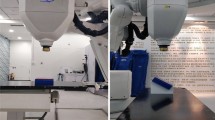Abstract
In a radiation treatment of a patient near the skin region, the superficial dose is an essential parameter. Halcyon™ is a newly developed machine with a jawless and dual-layer multi-leaf collimator (MLC, Varian Medical Systems, Palo Alto, CA) offering a single 6 MV flattening filter-free (FFF) X-ray beams. These characteristics of Halcyon™ increase the surface dose by 10% compared to other c-arm-type linear accelerator with 6 MV filtered beams. This study aims at investigating superficial dose reduction using lead foil in Halcyon™. The lead foil of thickness 1 mm was attached below the bore to produce a beam hardening and reducing head scattered electrons. The superficial dose was evaluated with film dosimetry on water equivalent phantom, and the beam quality was evaluated with percentage depth dose on three-dimensional water phantom. Plan comparison of each case was performed with the Acuros XB algorithm (Eclipse 15.6). The results of percentage depth dose measurements showed that the Dmax was in good agreement with and without lead foil at 1.24 cm depth, and the beam quality factor (kQ) was well matched with the values of 0.9975 and 1.0006. Furthermore, the film measurement results showed a 4% reduction in the superficial dose upon using the lead foil case. For the plan dose calculation and phantom measurement, the superficial dose was also reduced by 5–10% when 1-mm lead foil was attached on the Halcyon™ bore. The application of attaching a 1-mm thick lead foil to the bore of Halcyon™ machine could be a useful option to reduce the surface dose in the FFF beam.



Similar content being viewed by others
References
T. Netherton et al., Med Phys 46, 4304 (2019)
S. Michiels et al., Radiother Oncol. 128, 479 (2018)
D. Georg, T. Knoos, B. McClean, Med. Phys. 38, 1280 (2011)
F. O’Grady et al., Adv. Radiat. Oncol. 5, 120 (2020)
S.M. Bentzen, Nat. Rev. Cancer 6, 702 (2006)
S. Kumar et al., J. Med. Imaging Radiat. Oncol. 54, 264 (2010)
S. Devic, Phys. Med. 27, 122 (2011)
S. Devic et al., Med. Phys. 33, 1116 (2006)
L. Apipunyasopon et al., J Radiat Res 54, 374 (2013)
S. Tamilarasu, M. Saminathan, P. Anjali, S.K. Sharma, A. Dewan, Asian Pac J Cancer Prev 18, 1377 (2017)
A. Arslan, B. Sengul, Sci. Rep. 10, 1 (2020)
Acknowledgements
This research was supported by the National Research Foundation of Korea (NRF) grant funded by the Korea government (MSIT) (NRF-2020R1F1A1075802)
Author information
Authors and Affiliations
Corresponding author
Additional information
Publisher's Note
Springer Nature remains neutral with regard to jurisdictional claims in published maps and institutional affiliations.
Rights and permissions
Springer Nature or its licensor holds exclusive rights to this article under a publishing agreement with the author(s) or other rightsholder(s); author self-archiving of the accepted manuscript version of this article is solely governed by the terms of such publishing agreement and applicable law.
About this article
Cite this article
Kim, Sw., Lee, U., Song, S.Y. et al. Feasibility of a superficial dose reduction technique with a lead foil in Halcyon™. J. Korean Phys. Soc. 81, 1169–1173 (2022). https://doi.org/10.1007/s40042-022-00576-x
Received:
Revised:
Accepted:
Published:
Issue Date:
DOI: https://doi.org/10.1007/s40042-022-00576-x




